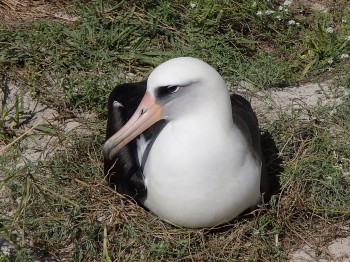Frances Nilsen (Hawai’i Pacific University, Kane’ohe, Hawaii, USA) and colleagues have looked at the various types of plastic ingested by Laysan Albatrosses Phoebastria immutabilis, publishing in the Marine Pollution Bulletin.
The paper’s abstract follows:
“Laysan albatross (Phoebastria immutabilis) ingest plastic marine debris of a wide range of shape, sizes and sources. To better characterize this plastic and provide insights regarding its provenance and persistence in the environment, we developed a simple method to classify plastic fragments of unknown origin according to the resin codes used by the Society of Plastics Industry. Known plastics were analyzed by gas chromatography–mass spectroscopy (GC–MS) to identify indicator chemicals characteristic of each plastic resin. Application of this method to fragments of ingested plastic debris from boluses of Laysan albatross from Kure Atoll, Hawai’i, yielded proportions of 0.8% High Density Polyethylene, 6.8% Polystyrene, 8.5% Polyethylene Terephthalate, 20.5% Polyvinyl Chloride and 68.4% Polypropylene. Some fragments were composed of multiple resin types. These results suggest that infrequently recycled plastics are the dominant fragments ingested by albatross, and that these are the most prevalent and persistent resin types in the marine environment.”

Laysan Albatross, photograph by Peter Leary
Reference:
Frances Nilsen, F., Hyrenbach, K.D., Fang, J. & Jensen, B.2014. Use of indicator chemicals to characterize the plastic fragments ingested by Laysan albatross. Marine Pollution Bulletin DOI: 10.1016/j.marpolbul.2014.07.055.
John Cooper, ACAP Information Officer, 31 August 2014

 English
English  Français
Français  Español
Español